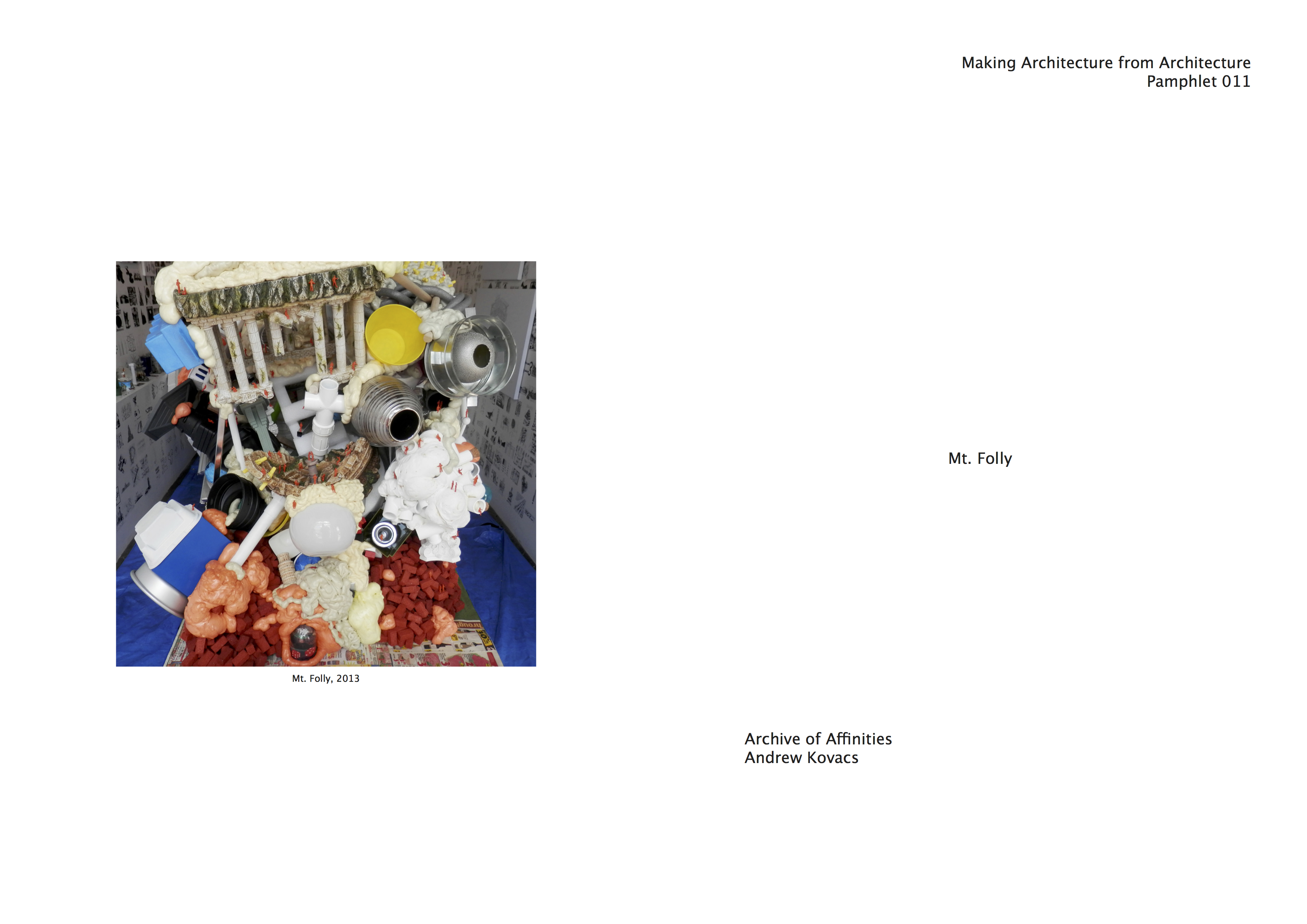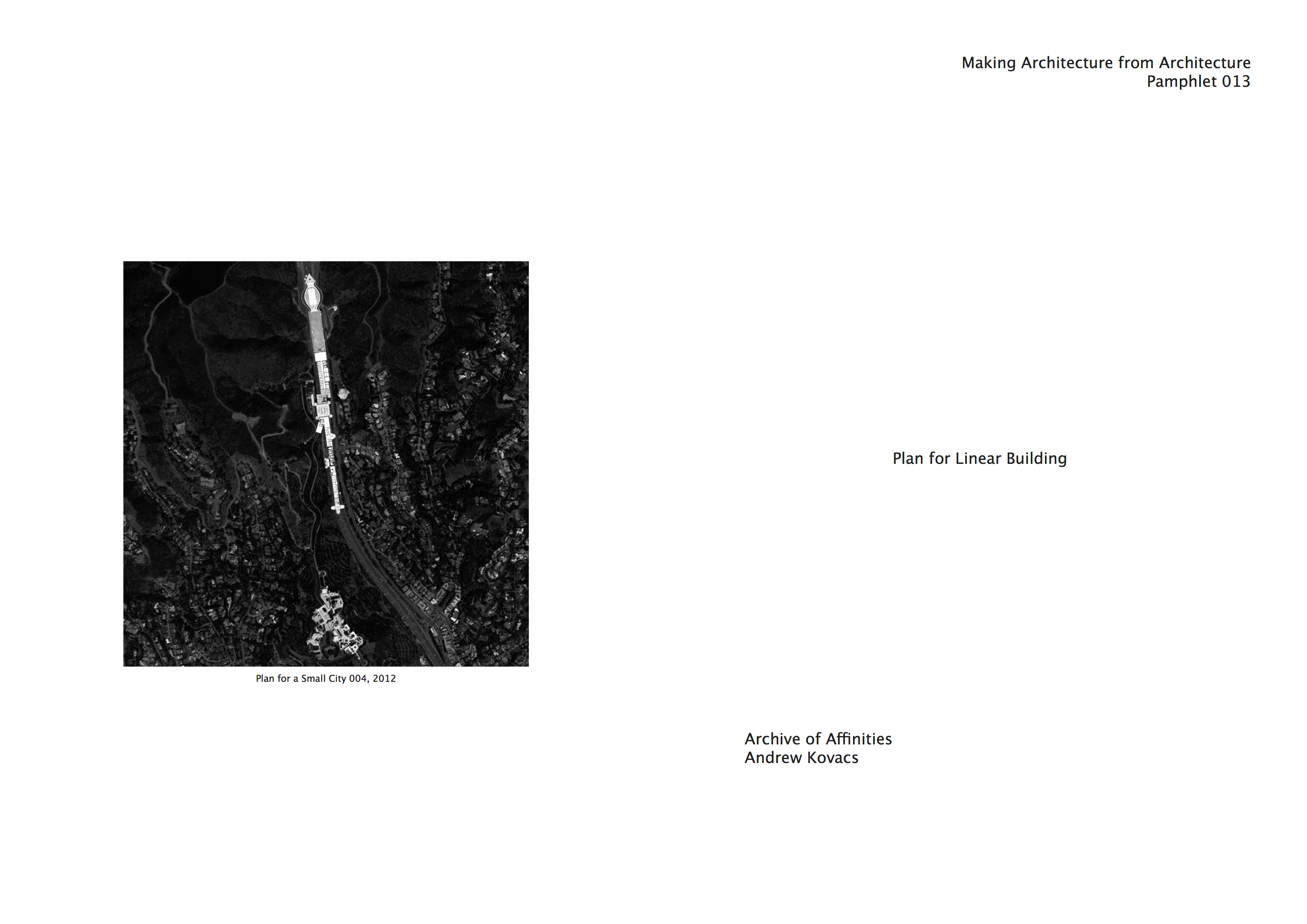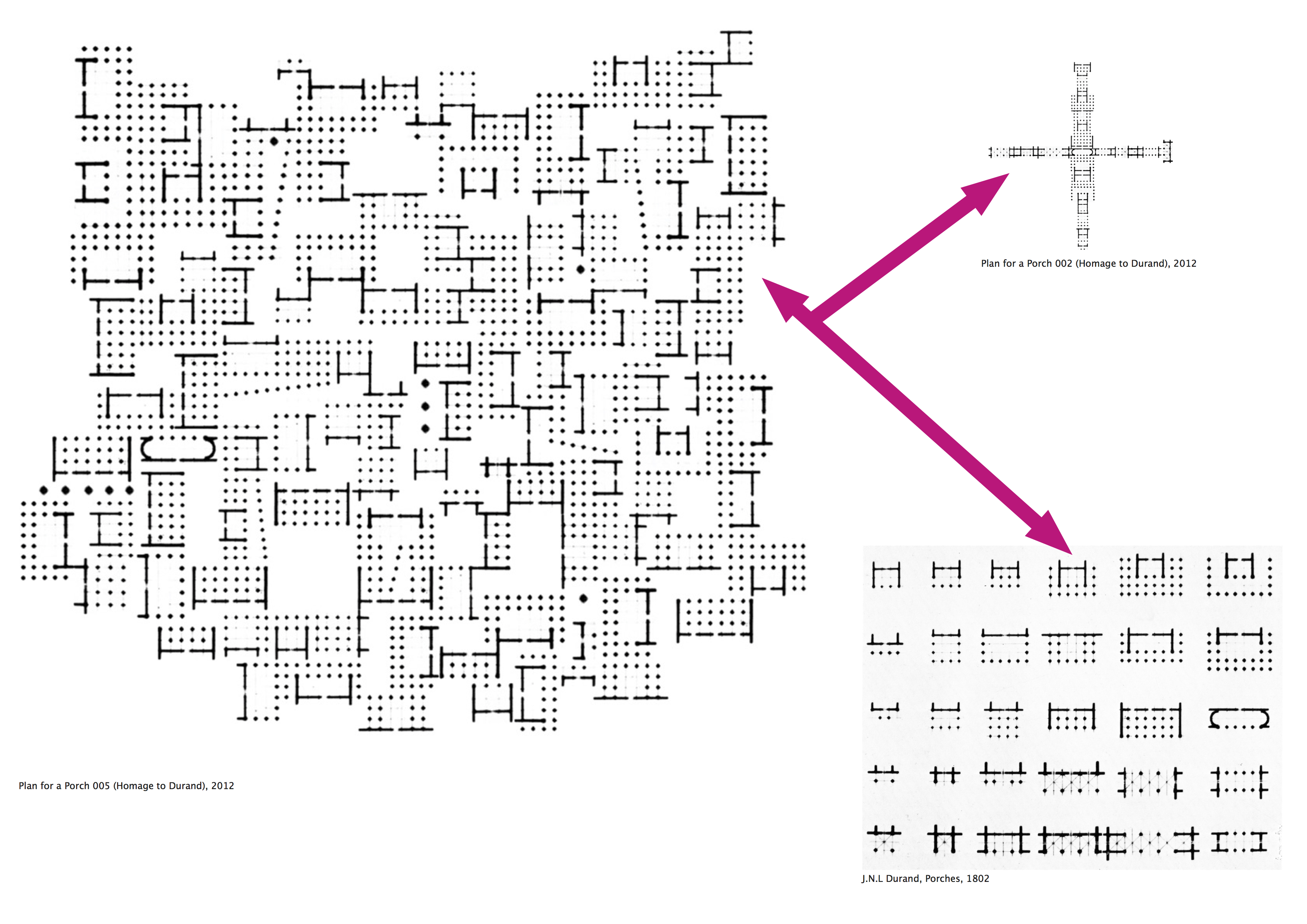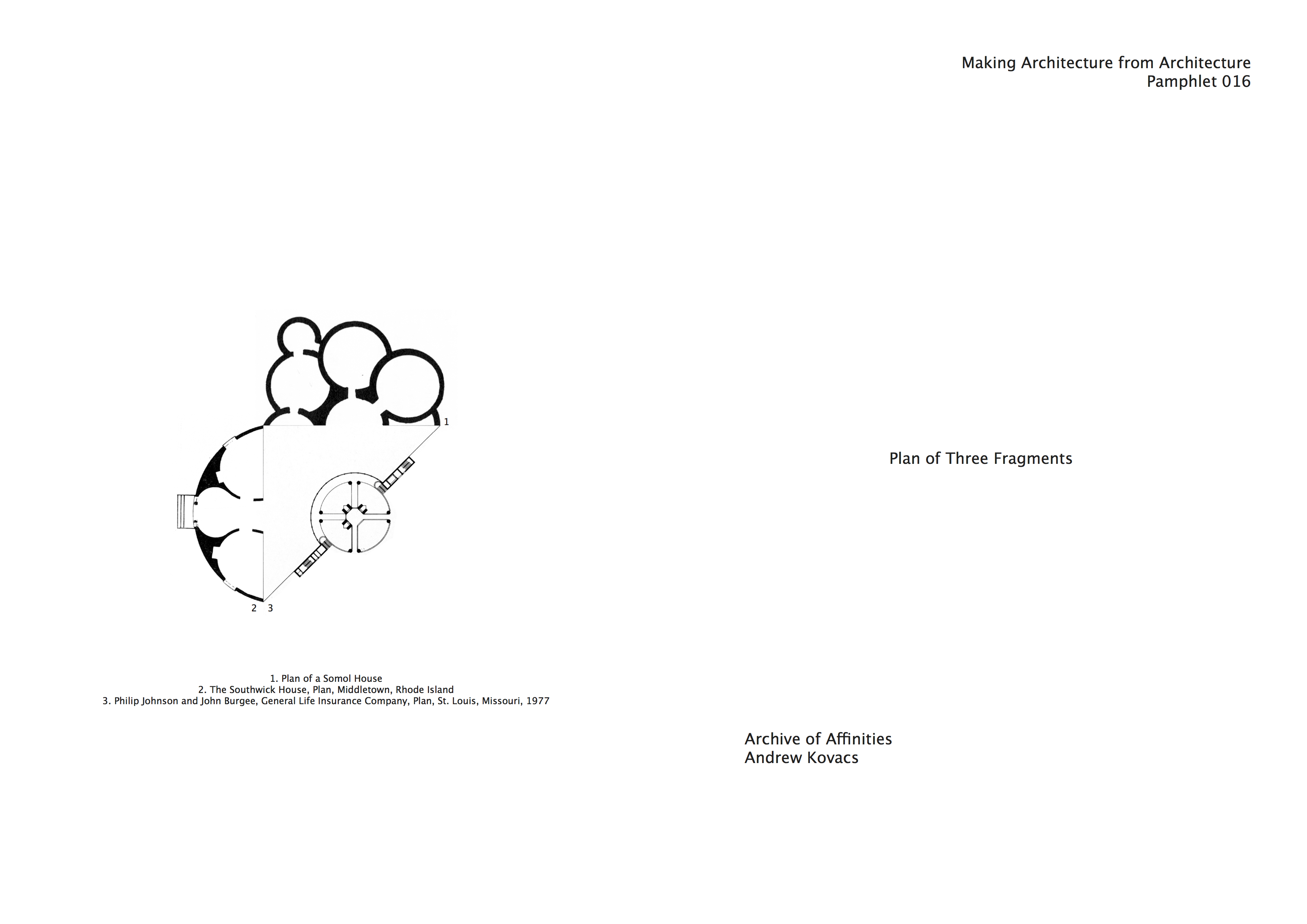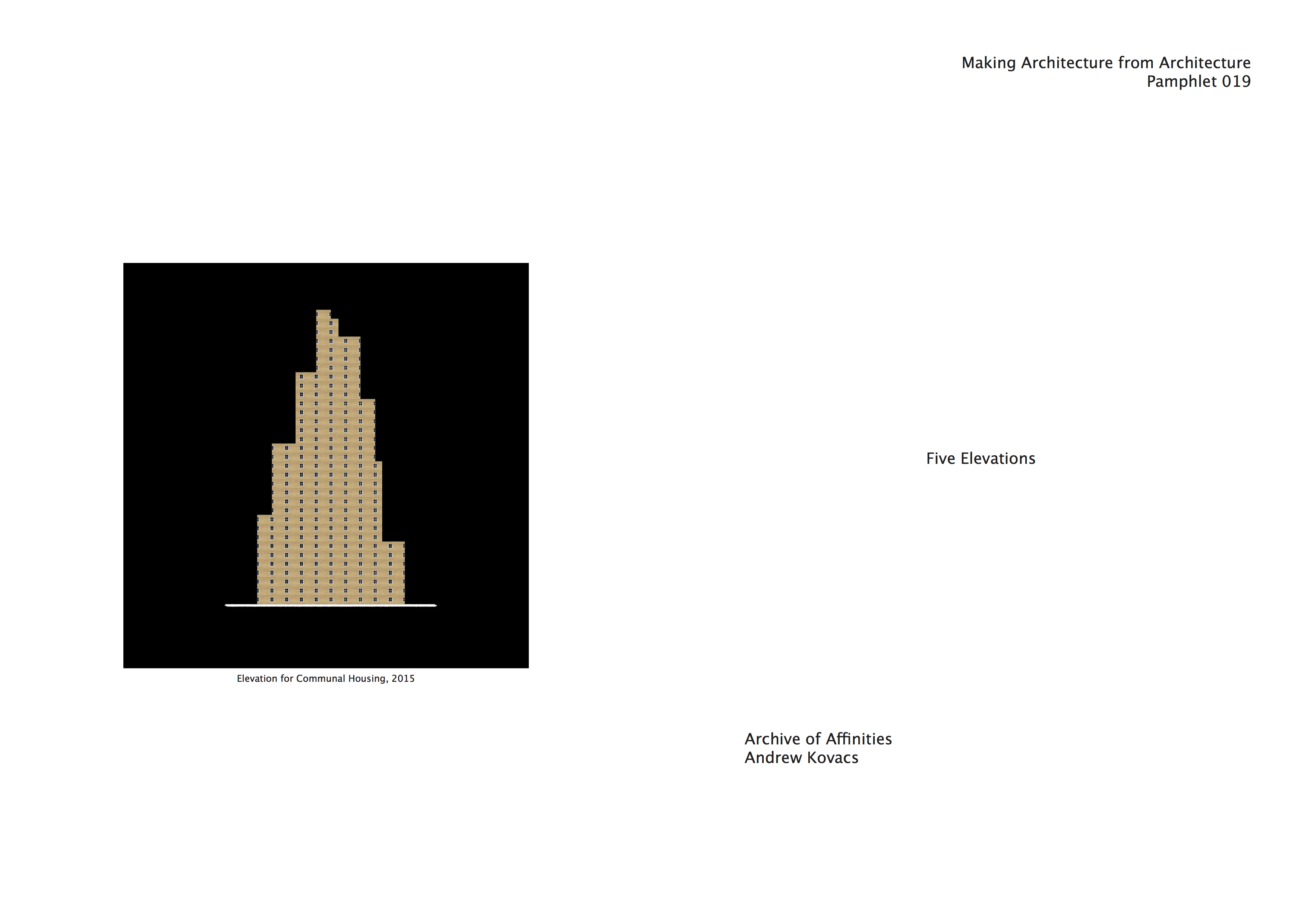
UNFOLDING PAVILION
Team: Andrew Kovacs, 2016
10 Steps for Making Architecture from Architecture:
1) Making Architecture from Architecture
Making Architecture from Architecture is a pursuit with the aim of grasping the width and depth of architecture. If architecture is a way that we organize the world around us, then Making Architecture from Architecture is about evaluating what exists and rearranging that material towards architectural purposes. This is a pursuit that tracks the qualities and traits of architecture.
2) Definition
Making Architecture from Architecture requires that architecture first must be defined and identified. Not everything and anything can be architecture, but what is architecture may at first be unexpected. Making Architecture from Architecture is sympathetic in outlook so it can discover what architecture is. Making Architecture from Architecture is relentlessly unbiased, inclusive and opportunistic: no architecture is greater, or less than any other architecture. All architecture is equal.
3) The Search
The material to Make Architecture from Architecture makes itself apparent during the search. This search is a state of controlled randomness. The search is not specific. While there is a selection criteria for this material, it is not based on individuals, theories, or movements. The material to Make Architecture from Architecture is the result of a incremental process of drifting and browsing. The search is painstaking and requires an investment in time. Often the search yields no apparent results.
4) The Selection
During the search, architectural images and objects are selected based on their qualities. The qualities range from size, form, shape, mass, proportion, character, posture, figure, organization, distribution, color, recognizability, and so on. Selection is about making choices. The materials selected may appear to be wholes but are to be understood as fragments. Fragments that are extradited from the baggage of their original context, and placed into a reserve where they wait to be redeployed in a new context.
5) The Scanner
Once images and objects are selected they are scanned. The scanner is a leveling device for all gathered images and objects. The material that has been tracked and hunted is equalized first by scanning and then by archiving. The original context is erased. This record of scanned and archived images and objects is not an end itself, it is material waiting to be mobilized.
6) Archive of Affinities
Archive of Affinities is the complete up to date digital record of the search, the selection and the scanner. It follows a logic of producing affinities. As a continuously growing whole, Archive of Affinities reflects personal predilections, tastes, and interests. Archive of Affinities also creates relationships between digitally recorded images and objects. In the process of its generation Archive of Affinities is a barometer, measuring both individual and collective sensibilities.
7) The Image Bank
Archive of Affinities is similar to, but different than, an image bank. An architect’s image bank is a way to gather inspiration and measure their output with that of the past. At a certain volume of images, the image bank inevitably begins to chart lineages between architects and architecture. The image bank conforms to traditional hierarchical structures of time, movements, and individuals. Through comparison, the image bank becomes a tool of reference and precedent - one of the ways architects have previously attempted to make architecture from architecture. The architect’s image bank has an importance in this regard, but it is limited in that it has a static existence. The image bank is trapped by its organization and file structure. And more often then not this results in a convention of disorganization initiated by file mismanagement, real time updates, and miscellaneous categorization. However this convention of disorganization when pushed to an extreme becomes important in the endeavor of Making Architecture from Architecture.
8) No File (Mis)Management
An extreme lack of file management is different from file mismanagement. The most extreme lack of file management in the image bank places all images in a single folder and thus on an equal playing field. The openness of a single folder allows for serendipity. Lack of apparent organization compares and juxtaposes work that may have never had such an opportunity. Mess is more. The typical organization of the image bank forces material to remain separated and stationary, Making Architecture from Architecture views the material to be equal, transitory and awaiting assemblage. Once and image or object is recorded it becomes material that is available for the mobilization and production of new architectural images and objects. In the process of Making Architecture from Architecture, reference is exploited without reverence and precedent is employed perversely.
9) Comparison, Contiguity, and Composition
Making Architecture from Architecture is the production of the new from the existing. Comparison places all recorded affinities on equal footing and allows for the manipulation and alteration of the qualities or affinities such as scale, form, organization, and context. Contiguity is comparison pushed to its extreme. It occurs when the distance required to compare is collapsed and reduced to zero. In doing so, the composition of these altered elements is integral. Making Architecture from Architecture aims to produce new and radically contiguous compositions of the existing.
10) Production Through Addition
The undertaking of Making Architecture from Architecture operates on two levels. The first level employs procedures of browsing, searching, tracking, gathering, grouping, organizing, comparing, collecting, and selecting. The second aspect of making architecture from architecture is the constant production of new images and objects through procedures of flattening, copying, scaling, assembling, combining, compacting, mixing, reorganizing, altering, recasting, and proposing. The new productions might simply be architectural thought experiments, playful provocations, or speculative proposals. This process takes the material that was tracked and hunted and assembles it. This is ultimately a process of addition. Production is dependent on existing architectural images and objects that have been scanned and recorded in Archive of Affinities. The more that is gathered, the more can be produced. The material that is recorded may exist as a collection, but it does not remain as a collection. A collection is a terminus. In a collection once an image or object is acquired it has reached its end. Making Architecture from Architecture employs the logic of a collection, but it ultimately pushes that logic to a breaking point.
Making Architecture from Architecture is a pursuit with the aim of grasping the width and depth of architecture. If architecture is a way that we organize the world around us, then Making Architecture from Architecture is about evaluating what exists and rearranging that material towards architectural purposes. This is a pursuit that tracks the qualities and traits of architecture.
2) Definition
Making Architecture from Architecture requires that architecture first must be defined and identified. Not everything and anything can be architecture, but what is architecture may at first be unexpected. Making Architecture from Architecture is sympathetic in outlook so it can discover what architecture is. Making Architecture from Architecture is relentlessly unbiased, inclusive and opportunistic: no architecture is greater, or less than any other architecture. All architecture is equal.
3) The Search
The material to Make Architecture from Architecture makes itself apparent during the search. This search is a state of controlled randomness. The search is not specific. While there is a selection criteria for this material, it is not based on individuals, theories, or movements. The material to Make Architecture from Architecture is the result of a incremental process of drifting and browsing. The search is painstaking and requires an investment in time. Often the search yields no apparent results.
4) The Selection
During the search, architectural images and objects are selected based on their qualities. The qualities range from size, form, shape, mass, proportion, character, posture, figure, organization, distribution, color, recognizability, and so on. Selection is about making choices. The materials selected may appear to be wholes but are to be understood as fragments. Fragments that are extradited from the baggage of their original context, and placed into a reserve where they wait to be redeployed in a new context.
5) The Scanner
Once images and objects are selected they are scanned. The scanner is a leveling device for all gathered images and objects. The material that has been tracked and hunted is equalized first by scanning and then by archiving. The original context is erased. This record of scanned and archived images and objects is not an end itself, it is material waiting to be mobilized.
6) Archive of Affinities
Archive of Affinities is the complete up to date digital record of the search, the selection and the scanner. It follows a logic of producing affinities. As a continuously growing whole, Archive of Affinities reflects personal predilections, tastes, and interests. Archive of Affinities also creates relationships between digitally recorded images and objects. In the process of its generation Archive of Affinities is a barometer, measuring both individual and collective sensibilities.
7) The Image Bank
Archive of Affinities is similar to, but different than, an image bank. An architect’s image bank is a way to gather inspiration and measure their output with that of the past. At a certain volume of images, the image bank inevitably begins to chart lineages between architects and architecture. The image bank conforms to traditional hierarchical structures of time, movements, and individuals. Through comparison, the image bank becomes a tool of reference and precedent - one of the ways architects have previously attempted to make architecture from architecture. The architect’s image bank has an importance in this regard, but it is limited in that it has a static existence. The image bank is trapped by its organization and file structure. And more often then not this results in a convention of disorganization initiated by file mismanagement, real time updates, and miscellaneous categorization. However this convention of disorganization when pushed to an extreme becomes important in the endeavor of Making Architecture from Architecture.
8) No File (Mis)Management
An extreme lack of file management is different from file mismanagement. The most extreme lack of file management in the image bank places all images in a single folder and thus on an equal playing field. The openness of a single folder allows for serendipity. Lack of apparent organization compares and juxtaposes work that may have never had such an opportunity. Mess is more. The typical organization of the image bank forces material to remain separated and stationary, Making Architecture from Architecture views the material to be equal, transitory and awaiting assemblage. Once and image or object is recorded it becomes material that is available for the mobilization and production of new architectural images and objects. In the process of Making Architecture from Architecture, reference is exploited without reverence and precedent is employed perversely.
9) Comparison, Contiguity, and Composition
Making Architecture from Architecture is the production of the new from the existing. Comparison places all recorded affinities on equal footing and allows for the manipulation and alteration of the qualities or affinities such as scale, form, organization, and context. Contiguity is comparison pushed to its extreme. It occurs when the distance required to compare is collapsed and reduced to zero. In doing so, the composition of these altered elements is integral. Making Architecture from Architecture aims to produce new and radically contiguous compositions of the existing.
10) Production Through Addition
The undertaking of Making Architecture from Architecture operates on two levels. The first level employs procedures of browsing, searching, tracking, gathering, grouping, organizing, comparing, collecting, and selecting. The second aspect of making architecture from architecture is the constant production of new images and objects through procedures of flattening, copying, scaling, assembling, combining, compacting, mixing, reorganizing, altering, recasting, and proposing. The new productions might simply be architectural thought experiments, playful provocations, or speculative proposals. This process takes the material that was tracked and hunted and assembles it. This is ultimately a process of addition. Production is dependent on existing architectural images and objects that have been scanned and recorded in Archive of Affinities. The more that is gathered, the more can be produced. The material that is recorded may exist as a collection, but it does not remain as a collection. A collection is a terminus. In a collection once an image or object is acquired it has reached its end. Making Architecture from Architecture employs the logic of a collection, but it ultimately pushes that logic to a breaking point.

1000 pamphlets installed in the bedroom closet. Photo by: Andrea Avezzù.
20 Pamphlets for Making Architecture from Architecture:




















